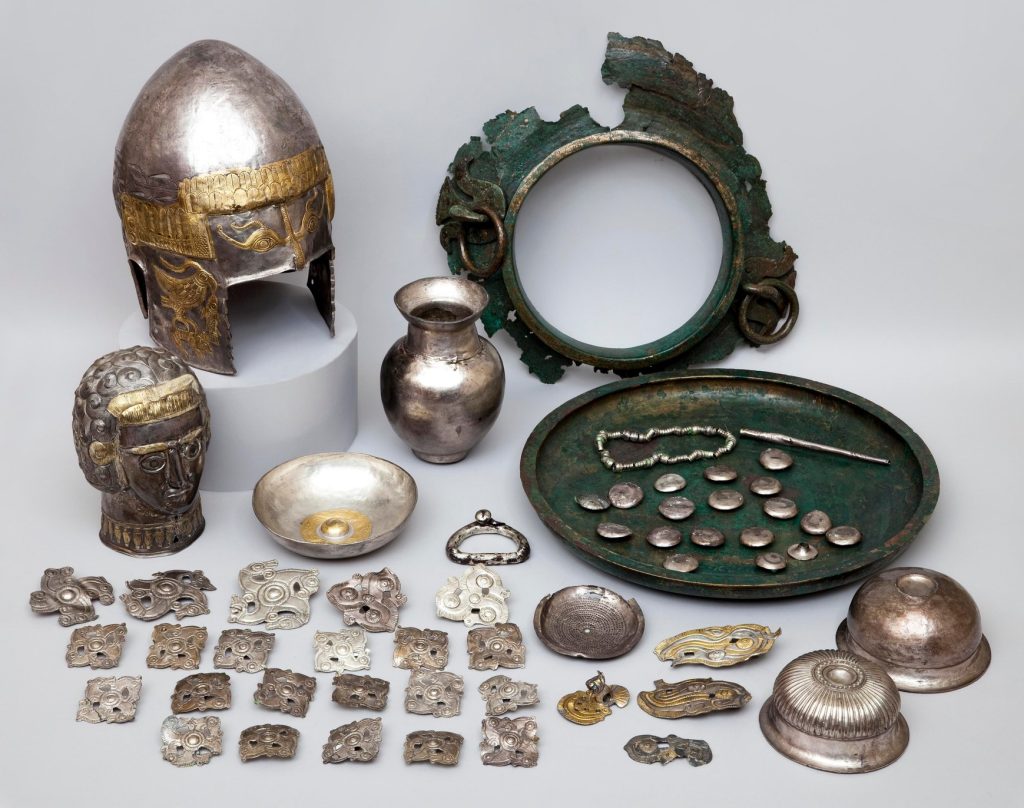In the summer of 1970, an extraordinary archaeological discovery was made in the southeastern region of Peretu commune, Romania. While farmers were engaged in their routine activity of plowing fields, they stumbled upon a tomb that belonged to a royal figure from the late 4th century BC. This accidental find led to a comprehensive excavation that unveiled a treasure trove of artifacts and provided a deeper understanding of the cultural and historical richness of the Geto-Dacian people.
When archaeologists began to explore the tomb, they unearthed the skeleton of a man, accompanied by the remains of several animals: the head and legs of a horse, two dogs, and a Bovidae. The tomb also housed a collection of Getic ceramic vessels, iron weapons, and components of a four-wheeled iron hearse. These initial findings hinted at the remarkable inventory awaiting discovery within the tomb’s confines.

As the excavation progressed, a vast array of objects made from silver, bronze, and copper came to light. Among these artifacts were a helmet or crown, a possible rhyton vessel, an aryballos-type container, three phiale vessels, appliques, buttons, beads, a colander, a tray, and a cauldron. These items offered a glimpse into the opulent lifestyle and advanced craftsmanship of the Geto-Dacian royal elite. The intricate artistry and symbolic designs on these objects underscored the sophistication of their creators and their importance in rituals and ceremonies.
One of the most intriguing finds from the tomb was a silver and gold head, widely believed by historians and archaeologists to represent a rhyton depicting a female persona. However, its exact purpose and significance remain subjects of debate. Typically, rhytons were used in rituals or celebrations, with their unique design often requiring the vessel to be turned upside-down during use—an unusual characteristic in ceremonial art. The presence of small holes in the neck of the head suggests that it may have been fastened to a staff or scepter, adding another layer of mystery to its function.
The identity of the character represented by the rhyton remains uncertain. If it is a male figure, the head might symbolize Apollo, an astral deity revered by the Geto-Dacian and Thracian kings. On the other hand, if the figure represents a female persona, it could be the goddess Bendis, a prominent deity in Geto-Dacian mythology who, alongside Apollo, wielded influence over rulers and their symbols of power. This duality reflects the complex spiritual beliefs of the Geto-Dacian people, where divine authority and royal power were deeply intertwined.
Another significant artifact uncovered was a silver and gold helmet or crown, characteristic of the Getic style. Its design closely resembled helmets discovered at Agighiol and the Iron Gates, suggesting a shared cultural heritage or influence. This crown likely belonged to a lower-ranking member of the royal family, such as a general or a relative of the reigning king. The crown’s color, intricate artwork, and shape served multiple purposes: they signified the region of kingship, symbolized power, and identified specific deities during religious ceremonies, military parades, and other significant events.

The geographic origin and symbolic design of the crowns found in the tomb highlight their cultural and spiritual importance. The eyes depicted on the crowns are believed to represent Zamolxis, the central deity of the Geto-Dacian pantheon, or possibly the Throne of God. This connection underscores the sacred relationship between the royal figures and their divine protectors, reinforcing their legitimacy and authority through spiritual symbolism.
The discovery at Peretu commune provides an invaluable window into the culture and traditions of the ancient Geto-Dacians. The artifacts unearthed from the tomb reveal a society deeply invested in artistry, symbolism, and spiritual expression. The elaborate designs and the variety of materials used in the artifacts point to a highly skilled and resourceful community. Each object not only served a practical or ceremonial purpose but also conveyed messages of power, identity, and divine favor.
This remarkable find has allowed historians and archaeologists to piece together aspects of Geto-Dacian life that were previously shrouded in mystery. The intricate craftsmanship of the artifacts highlights the advanced metallurgical and artistic skills of the Geto-Dacian people. Moreover, the discovery sheds light on their hierarchical societal structure, where symbols of power and divine connection played a central role in governance and cultural identity.
The Peretu commune tomb stands as a testament to the enduring fascination with ancient civilizations and the allure of uncovering the secrets of the past. Each artifact recovered from this site tells a story of a people whose lives were intertwined with their environment, beliefs, and artistic expressions. As scholars continue to study these treasures, they gain deeper insights into the legacy of the Geto-Dacian civilization and its contributions to the broader tapestry of human history.
The artifacts from this discovery continue to captivate the imagination of researchers and the public alike. They offer not only a glimpse into the lives of an ancient society but also a reflection of universal human themes: the quest for power, the expression of spirituality, and the celebration of artistic achievement. The Peretu find remains a symbol of the enduring connection between humanity and its past, reminding us of the stories that lie buried beneath the earth, waiting to be uncovered and shared with the world.





